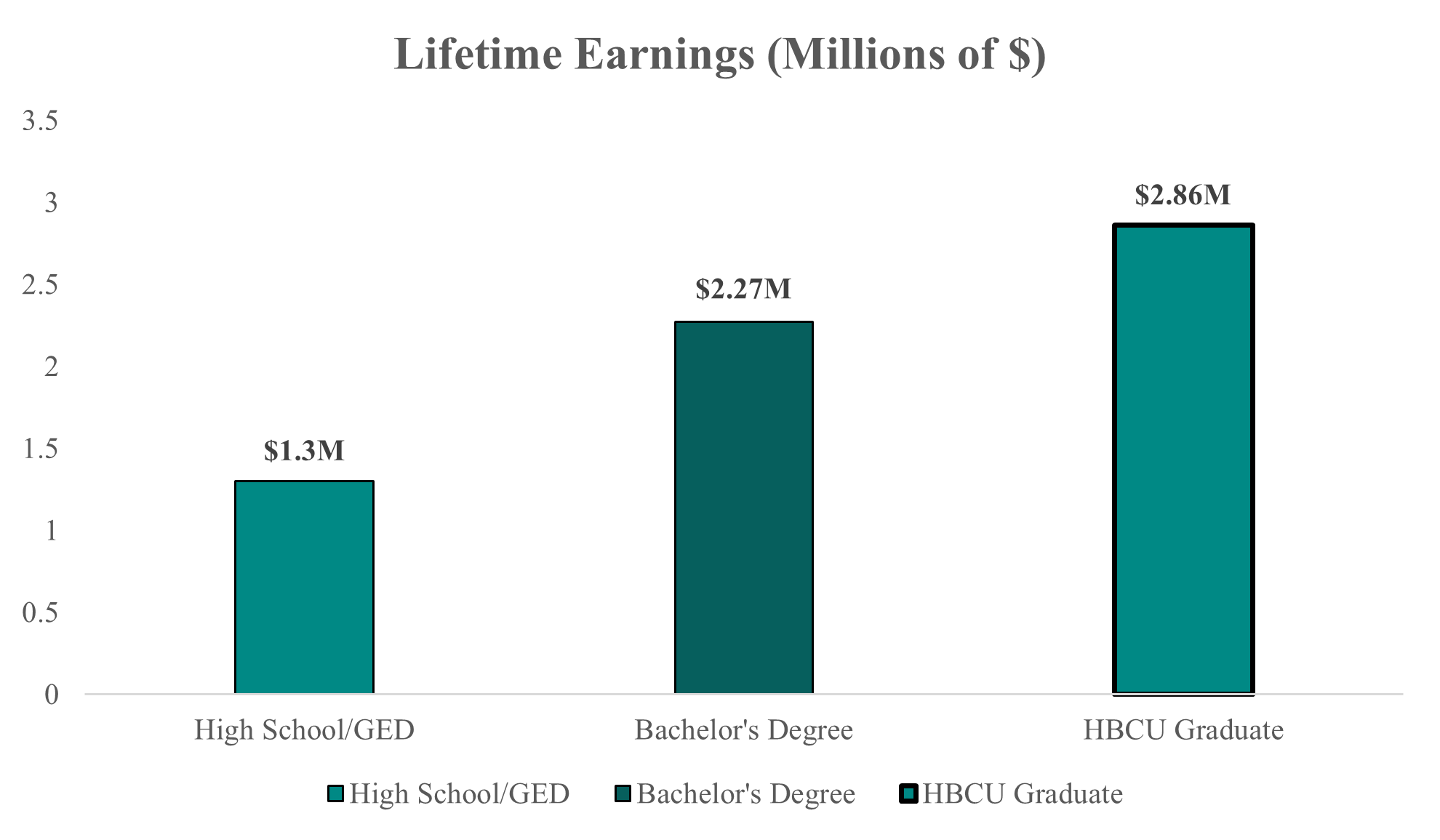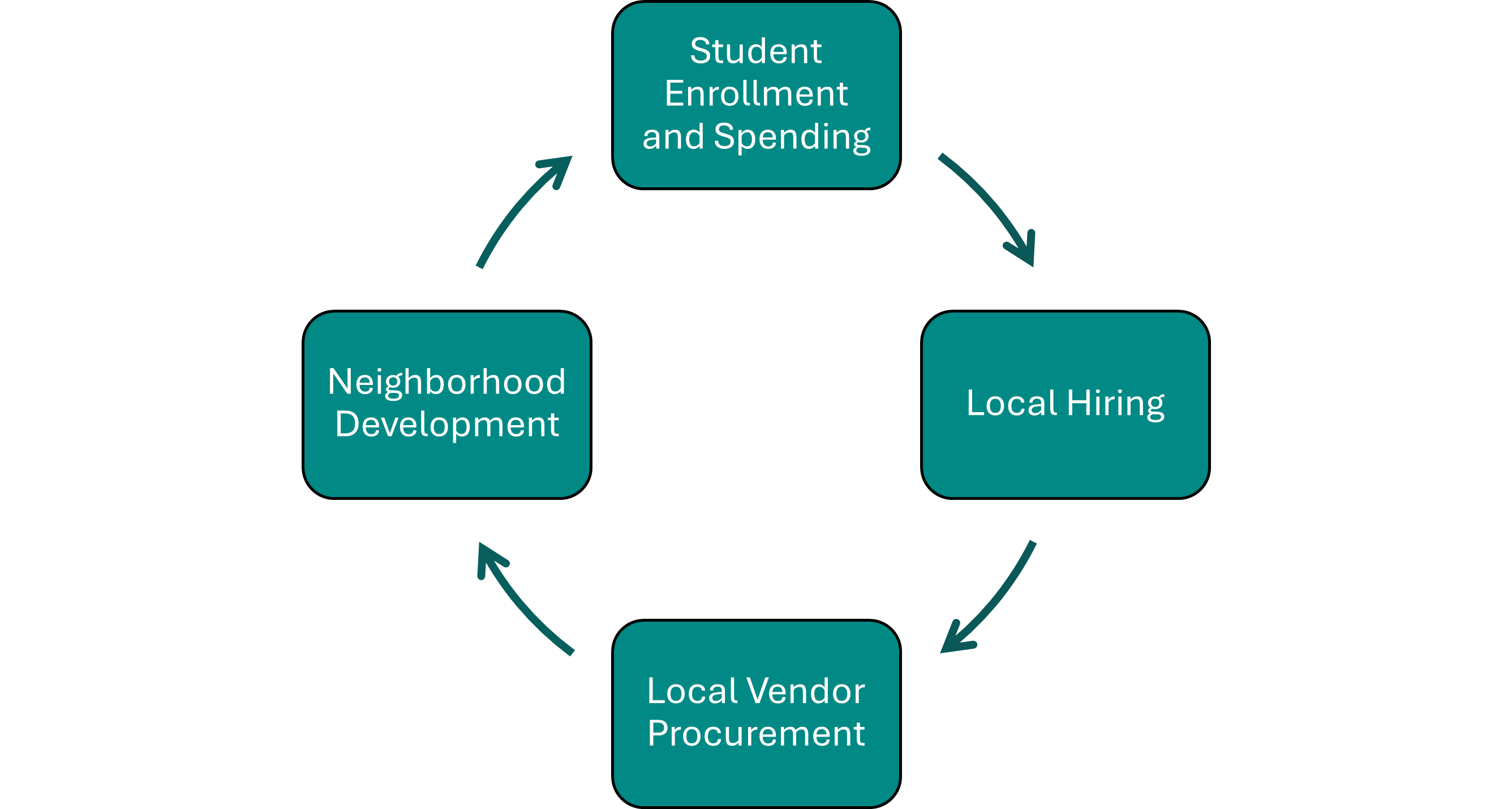From Campus to Community: How HBCUs Build Black Wealth and Power Local Economies
September 25th, 2025
Dr. Regina Moorer, Senior Policy Analyst
Historically Black Colleges and Universities (HBCUs) are more than places of learning. They serve as engines of economic mobility for Black students and act as anchor institutions for the surrounding communities. They educate more first-generation and low-income students than most predominantly White institutions (PWIs) – ushering first-generation and low-income students into higher earning brackets at scale.[1] For many Black families, an HBCU degree is the most reliable pathway to economic security.
According to the United Negro College Fund (UNCF), HBCUs generate $16.5 billion in annual economic output and support over 136,000 jobs nationwide.[2] Each $1 million spent by HBCU institutions and their students creates 12 jobs. Furthermore, for every dollar HBCUs and their students spend, an additional 43 cents circulates within the regional economy. The economic engine extends beyond the institution. It travels with the graduate. Together, these institutional and individual impacts show how HBCUs drive both regional economic growth and long-term wealth creation for their graduates.
HBCU Degrees Deliver Real Returns
Black adults with only a high school diploma or GED earn a median of about $1.36 million over their lifetime.[3] Earning a bachelor’s degree raises that figure to roughly $2.27 million. HBCU graduates see a greater payoff with additional lifetime earnings of $1,036,403, bringing their estimated total to approximately $2.86 million (See Figure 1). The Class of 2021, for example, is projected to earn $146 billion in lifetime wages.[4]
Figure 1: Estimated Lifetime Earnings of Black Adults by Education Level
HBCU graduates earn more over their lifetime than other Black Americans
Essentially, HBCU graduates can expect a lifetime earnings advantage of roughly $1 million more than Black adults with only a high school diploma and $600,000 more than the typical Black college graduate.
Research on economic mobility also confirms that HBCUs produce high-impact results. Most HBCUs rank in the 90th percentile nationally for helping students move from the bottom 40 percent of household income into the top 60 percent.[5] For Black students, HBCUs offer stronger mobility rates than many PWIs. A 2023 study found that students attending HBCUs are more likely to complete their degrees and earn higher wages.[6] Earlier research has also shown lasting economic benefits for HBCU graduates. Using nationally representative data dating back to the 1970s, researchers found that attending an HBCU is associated with higher wages and a higher probability of degree completion for Black students, compared with those who attend PWIs.[7]
HBCUs as Community Anchors
The impact of HBCUs extends far beyond their graduates. These institutions act as anchor institutions in communities that often lack stable employers, healthcare providers, or banks.[8] HBCUs hire locally, purchase from local vendors, and invest in neighborhood development (See Figure 2).
Figure 2: HBCU Anchor Economy Ecosystem
This figure shows how dollars move through the HBCU economy
The Federal Reserve’s Anchor Economy Initiative identifies higher education as one of the few remaining sectors that drive regional employment, especially in the South.[9] Many Southern communities have lost manufacturing and other traditional industries, leaving colleges and universities among the most stable employers and consumers of local goods and services. HBCUs fit this profile well, often ranking as top employers in their counties and acting as reliable sources of jobs, contracts, and investments. Their presence helps support local businesses, attracts new residents, and provides economic resilience in areas where other industries have declined.
HBCUs achieve economic impact while operating with significant underfunding. A 2023 analysis reveals that land-grant HBCUs have been underfunded by nearly $13 billion over the past thirty years compared to their predominantly White counterparts.[10] HBCU endowments remain a fraction of those at similarly sized PWIs.[11] The disparity in endowments has downstream effects: institutions with larger endowments can offer more scholarships, have more cushion during economic downturns, invest in research and technology, maintain facilities, and attract/retain faculty. HBCUs, with smaller endowments, are frequently constrained in those areas.
HBCUs also educate a much larger proportion of low-income students than most colleges, with over 80 percent of their undergraduates eligible for Pell Grants compared to about 34 percent nationally.[12] This concentration of financially vulnerable students forces HBCUs to stretch their already limited budgets further to provide more need-based aid, emergency grants, and flexible payment plans. Meanwhile, their students often rely heavily on federal loans and family borrowing. This heavy dependence on borrowing underscores the need for innovative funding partnerships that can ease financial strain and support broader community development.
CDFIs and HBCUs: Building Stronger Neighborhoods Together
Building long-term financial strength is essential, and partnerships with Community Development Financial Institutions (CDFIs) enable HBCUs to expand their financial stability. HOPE Credit Union’s HBCU-CDFI Economic Mobility Strategy Guide outlines how institutions like Jackson State University and Mississippi Valley State University partner with HOPE to address poverty in both rural and urban Black communities.[13]
Together, the HBCUs and their CDFI partner have implemented place-based strategies that include expanding affordable housing, developing small business corridors, improving access to healthy food, and providing targeted financial education. HOPE has already invested over $60 million in capital and operating support for HBCUs across the Deep South. Projects at Talladega College, Oakwood University, and Fisk University have helped modernize infrastructure, upgrade student housing, and broaden community-serving facilities.[14] These HBCU–CDFI partnerships demonstrate how local institutions can address systemic issues such as poverty, underinvestment, and racial wealth gaps when they have the necessary resources and partnerships to expand.
Why This Matters Now
HBCUs serve as catalysts for upward mobility, wealth creation, and neighborhood revitalization. Their graduates create better futures, their campuses boost local economies, and their missions align with the kind of equity-focused investments in the South and the country that are needed.
Additionally, the increasing record of HBCU–CDFI collaborations, exemplified by HOPE’s investments throughout the Deep South, shows how these partnerships turn HBCU missions into tangible results by funding new housing, growing small businesses, and building lasting community wealth. For funders, policymakers, and civic leaders, supporting HBCUs is a demonstrated strategy to increase Black wealth. If you aim to strengthen underserved communities, invest in HBCUs and their CDFI partners. The benefits are already evident in dollars, jobs, and improved lives.
[1] Federal Reserve Bank of Philadelphia. Anchor Impact: Understanding the Role of Higher Education and Hospitals in Regional Economies. 2022.
[2] “States Underfunded Historically Black Land Grants by $13 Billion Over 3 Decades,” Inside Higher Ed, September 2023.
[3] Moorer, Regina. Stronger Together: How CDFIs and HBCUs Build Lasting Change. (2025). http://hopepolicy.org/blog/stronger-together-how-cdfis-and-hbcus-build-lasting-change/
[4] Alexander, River. 2024. “Beyond Affirmative Action: HBCUs and the Time For Equitable Funding.” Columbia Political Review. https://www.cpreview.org/articles/2024/9/beyond-affirmative-action-hbcus-and-the-time-for-equitable-funding.
[5] HBCU-CDFI Economic Mobility Strategy Guide. https://www.hopecu.org/wp-content/uploads/2024/08/HBCU-CDFI-Economic-Mobility-Strategy-Guide.pdf
[6] Moorer, Regina. Stronger Together: How CDFIs and HBCUs Build Lasting Change. (2025). http://hopepolicy.org/blog/stronger-together-how-cdfis-and-hbcus-build-lasting-change/
[7] UNCF, HBCUs Transforming Generations: Social Mobility Outcomes for HBCU Alumni (2021).
[8] Edwards, Ashley; Ortagus, Justin; Smith, Jonathan; Smythe, Andria. HBCU Enrollment and Longer‑Term Outcomes (EdWorkingPaper 23‑883), November 2023.
[9] Fryer, Roland G., and Michael Greenstone. The Causes and Consequences of Attending Historically Black Colleges and Universities. NBER Working Paper No. 13036. 2007.
[10] McKinsey Institute for Black Economic Mobility, How HBCUs can accelerate Black economic mobility (2021).
[11] United Negro College Fund (UNCF), HBCUs Transforming Generations: Social Mobility Outcomes for HBCU Alumni, 2021.
[12] United Negro College Fund (UNCF), HBCUs Make America Strong: The Positive Economic Impact of Historically Black Colleges and Universities, 2017.
[13] Texas A&M University System. “Financial Impact of Educational Attainment by Race & Ethnicity.” Data Science Blog, September 15, 2023. https://www.tamus.edu/data-science/2023/09/15/financial-impact-of-educational-attainment-by-race-ethnicity/
[14] United Negro College Fund. Transforming Futures: The Economic Engine of HBCUs. Technical Report. 2024.







